We could never have known anything about the Etruscans, a people of ancient Italy who lived between the 9th and 1st centuries BC, if they had not given death the same importance as life. In the 7th and 6th centuries BC, when Etruscan civilization reached its military and cultural peak, houses and temples were built of perishable materials, but tombs were carved in stone since they were intended to last for eternity. Such burials, many of which are now carefully rediscovered, as in Monterozzi necropolis in Tarquinia, reflect an existential conception in which the transience of life was contrasted with a belief in an endless afterlife.
Etruscans and funerary rites
All we know about the Rasna (𐌀𐌍𐌔𐌀𐌓), as they were called, is known from funerary findings. The Etruscans had the custom of storing within the burial chambers everyday objects belonging to the deceased1, in an ideal continuity between life and death. Similarly, tomb architecture is also a testimony to the communal life, rituals and customs of this ancient people.
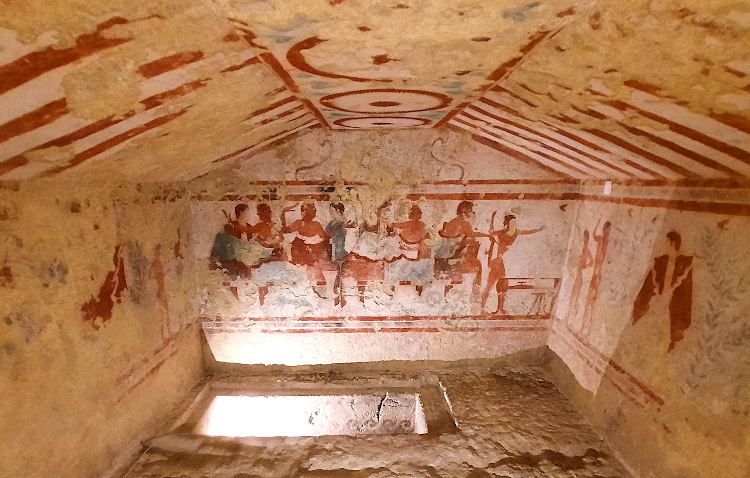
In addition to material evidence, in Etruscan tombs we can observe the evolution of burial procedures, which over time assimilated new belief systems and rituals2. The oldest well chambers of the Villanovan phase (10th-6th centuries B.C.) were functional for the ritual of incineration; the remains of the deceased were placed in biconical terracotta urns. Later, however, the Etruscans also began to adopt the rite of inhumation and, as a result, a new funerary architecture developed. These included mound tombs with access dromos (8th-6th centuries B.C.); hypogeum tombs carved out of tufa or peperino rock (7th-4th centuries B.C.); with tholos roofing and supporting column; aedicule tombs built in the open (6th-5th centuries B.C.); and dado tombs carved out of tufa rock blocks (6th-2nd centuries B.C.).
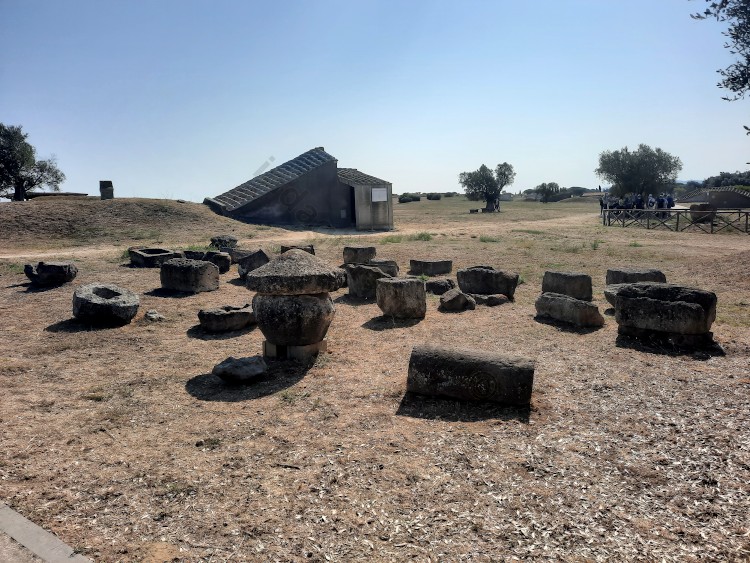
Life beyond death
Many aspects of Etruscan daily life are known to us, therefore, from grave goods and necklaces, jewelry and weapons placed inside tomb chambers. They were intended to accompany the deceased in transit to the afterlife: these were ritual objects with which a well-defined symbolic meaning was associated, but they are useful for reconstructing a material culture otherwise obscure to us. Thus, from hut-shaped urns it is known that Etruscan dwellings were built of wood and clay, with mud roofs. Similarly, temples were built, of which only the basements and wide access stairways have survived.
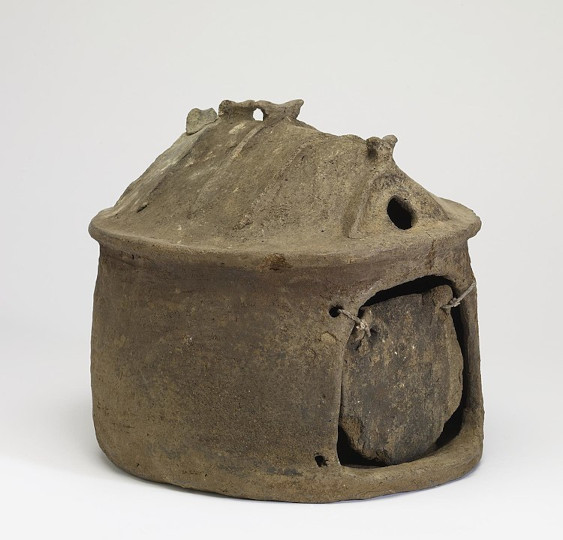
Likewise, Etruscan tombs reveal in the wealthy classes the use of fine clothing, as well as splendid jewelry obtained through high goldsmithing techniques. Etruscan goldsmiths were able to decorate thin sheets of gold, with granules as small as a tenth of a millimeter, through the technique of granulation.
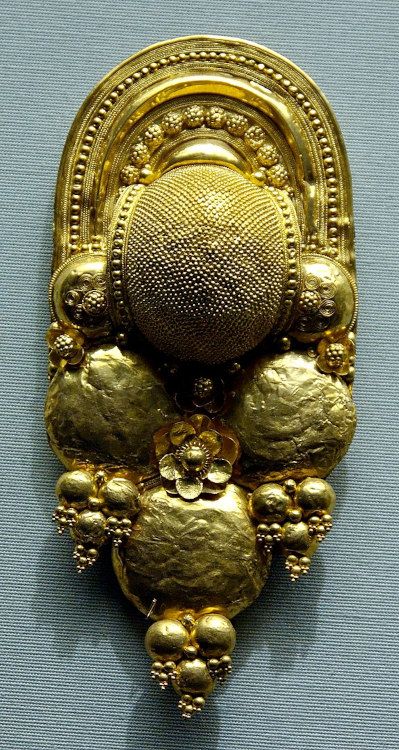
A boundary observation
On the other hand, reconstructing the civilization of the Etruscans only by burials contributes to making it so mysterious and elusive. Indeed, of them we do not know the origin, nor to which branch their language belonged. This is a boundary observation that cannot provide a clear anthropological image, but often transcends into an undefined mythical world. Etruscan tombs show an inextricable interweaving of habits of common living, abstract and imaginary thoughts, existential fears and religious beliefs.
Monterozzi necropolis of Tarquinia
Not far from the center of Tarquinia is located one of the most important Etruscan archaeological areas. Home to over six thousand tombs, some decorated with exceptional wall paintings, Monterozzi is the most important necropolis for observing Etruscan figurative art. The archaeological area has been a UNESCO heritage site since 2004 along with the Banditaccia necropolis in Cerveteri. Tarquinia’s tomb frescoes are accessible to visitors and can be observed through protective tempered glass panels.
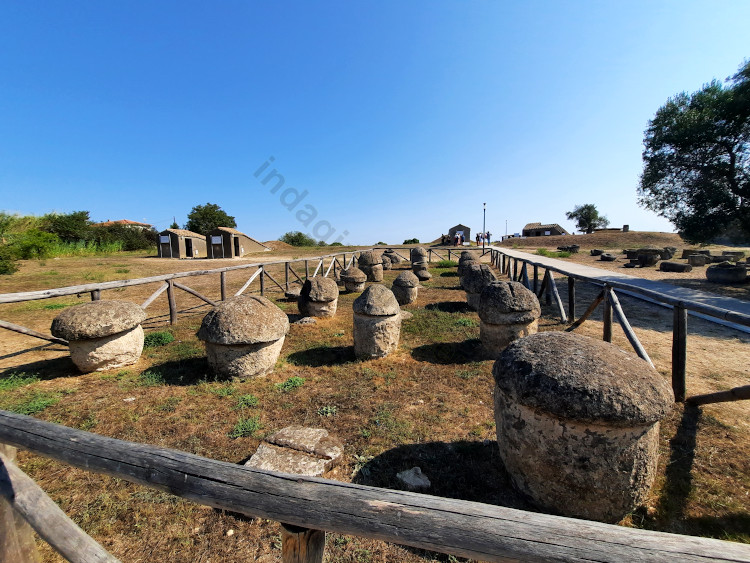
A destiny for eternity
The Etruscans, at least until the third century B.C., firmly believed in the continuity of life after death. Among the tens of thousands of tombs that were found, the vast majority had grave goods and furnishings necessary for the deceased to continue their existence in the afterlife. Existence in the afterlife continued similarly to how it had been in life. Thus the soldier had his weapons with him, the woman his jewelry, the merchant the tools that had belonged to him. Even the dwellings were faithfully reproduced within the burials. Thus we know that the Etruscans lived in houses with a simple, rectilinear plan, with coffered ceilings or supported by beams. There are reproductions of columns, curtains, furniture and doors in the burial chambers. The Etruscans ascribed to each individual, as a person, a purpose in life, an ultimate destiny that continued into eternity.
The demon Phersu
It is no coincidence that the etymology of the Latin word persona, meaning mask, is derived from the name of the Etruscan demon Phersu. Phersu was the figure of a divine and good guide who was often represented inside tombs. The demon was impersonated by a masked actor3 and officiated the rite of passage to the afterlife. Phersu thus symbolized the deceased’s proper habitus, the role he or she had played in society and was to be renewed forever in the afterlife.
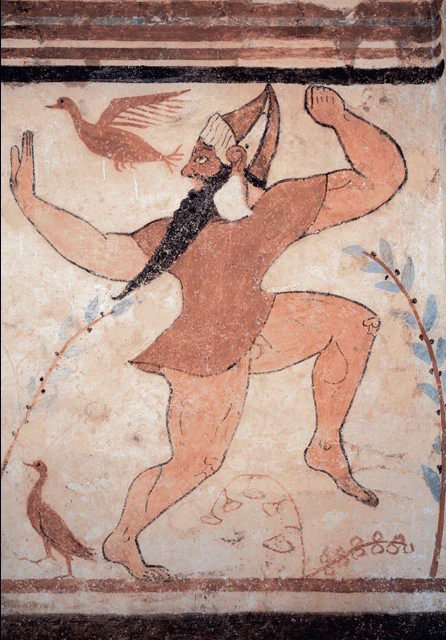
At Tarquinia the depiction of Phersu is frequent in mound tombs from the 6th century B.C.E., such as the Tomb of the Augurs. The wall paintings of that period manifest a joyful and enjoyable character, and include food, banquets, hunting scenes, cutlery and frying pans, even a radial plate that had the task of draining the fried oil from fish. Often the figures show the typical archaic smile. In general, the purpose was to portray the passing as a natural event, as if from reality there was no detachment.
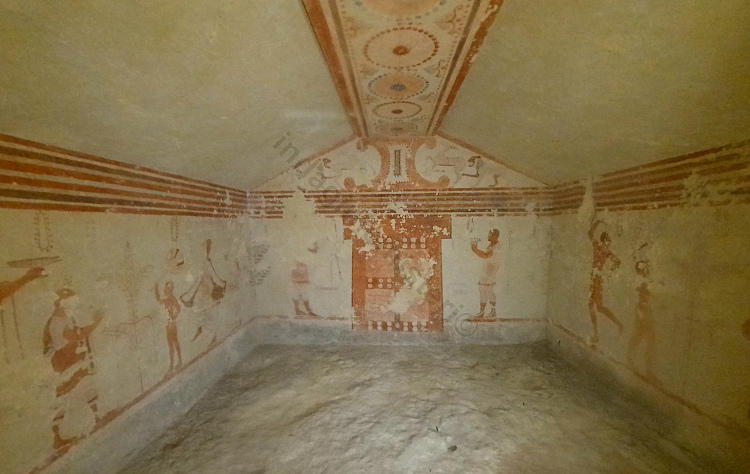
The emancipation of women
The funerary frescoes of the ancient Etruscans also allow us to pick up some clues about the ways of life and social customs. For example, they suggest that women were considered to be of equal status with men, as evident from the clay sarcophagi that remain today. In the representations they were mostly referred to by their proper names (Velelia, Ramutha, Thania, Larthia are cited as examples), a sign of their importance in society, and placed next to their husbands; often the two spouses were depicted on convivial beds called klines.
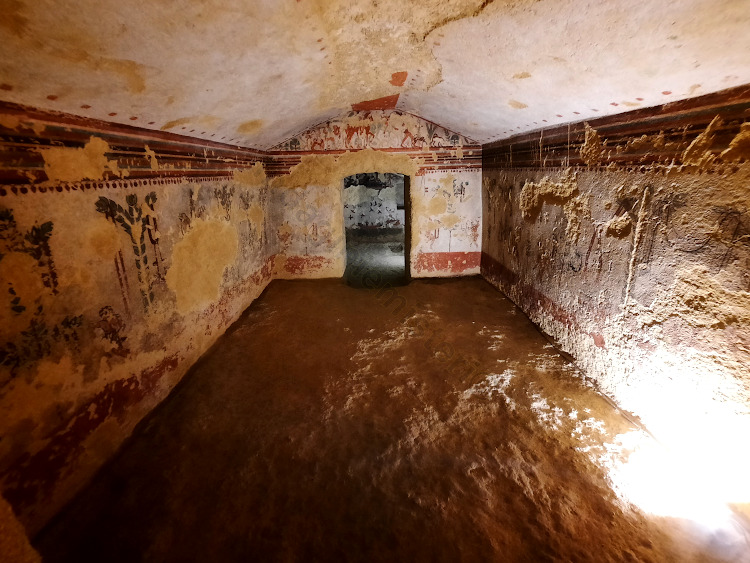
Paintings of banquets reveal gracious and unformal customs: the Etruscans ate comfortably lying down, side by side. It is not uncommon to observe newlyweds holding an egg between them, a symbol of rebirth. The participation of women at banquets was the cause of backbiting by the Greeks and Romans, who used the term Etruria as a synonym for prostitute.
Monterozzi necropolis and the gods of the underworld
The wall paintings of the tombs of Tarquinia, as well as many others spread along the Etruscan dodecapolis, host depictions of gods, demons, and guiding spirits from beyond the grave. Among these, the presence of dolphins, who were spiritually tasked with guiding the deceased to the afterlife, is characteristic. This was, perhaps, a legacy of the times when the Etruscans were fearsome pirates; similarly, the sea and the waters symbolically marked the passing. They did not consider death a state of being but only a moment of passage.
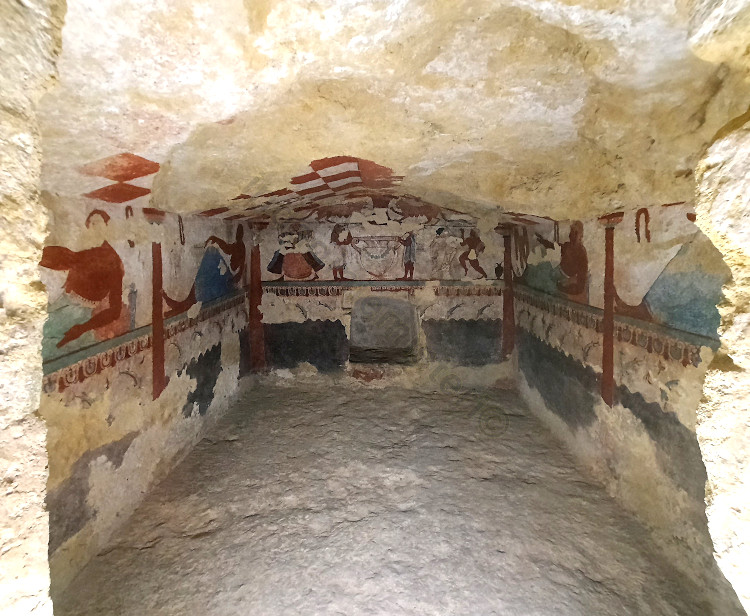
The path of the underworld
The Etruscans believed that the deceased was accompanied to the afterlife by certain deities, transcendent beings whose task was to facilitate the transit. In an earlier phase of Etruscan civilization, which could be described as one of carefree and joyful death, the mere task of such entities was to show the way to the afterlife.
Calu, a deity depicted with canine features4, was the personification of the moment of death, like the Greek Tanathos. Then there were the guardians of the threshold: Culsu was a female being, equipped with scissors to sever the thread of fate, and was associated with the male paredra deity Culsans. Like the Roman Janus, Culsans was depicted as two-faced, since he looked both to the past and to the future. Once through the gateway to the underworld, the deceased were taken over by Scylla, a gentle demon in the guise of a bicaudate fish, who accompanied them into their new life. Here the winged female demon Vanth lit the way with her torch, guarding the scroll of fate.
The coming of anguish before death
From the 5th-4th centuries B.C.E., fostered by a period of decline in Etruscan civilization started with the defeat against the Syracusan fleet at Cumae in 474 B.C., the conception of death changed. This is evident in the wall paintings that became expressions of existential anguish and deep uncertainty about man’s ultimate fate, perhaps taken from Greek culture. Thus arose the idea that the soul of the deceased had to merit the happy passing, and atone for its sins, to reach a realm of the dead like the Avernus. Here is the appearance of sepulchral frescoes with demons of judgment and correction, such as Tuchulcha and Charun. Charun, depicted with a vulture’s beak and pointed ears, fixed a nail on the foreheads of the dead with a hammer in order to free their souls.
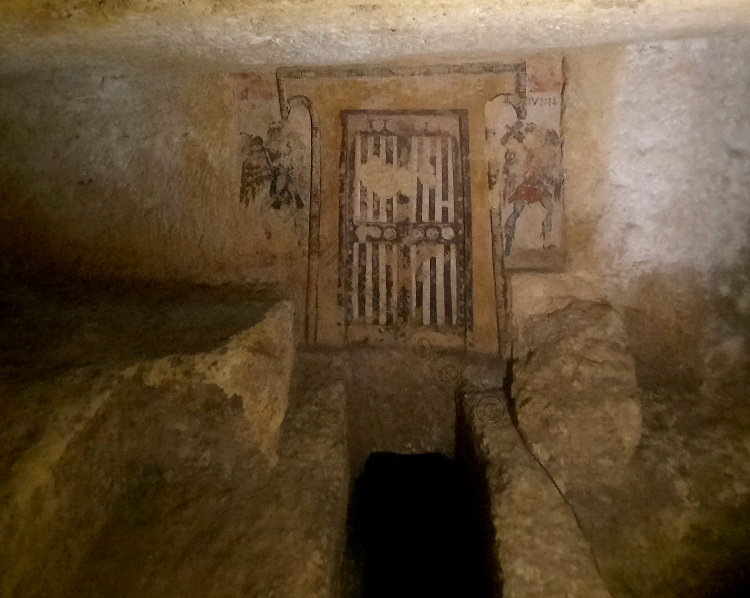
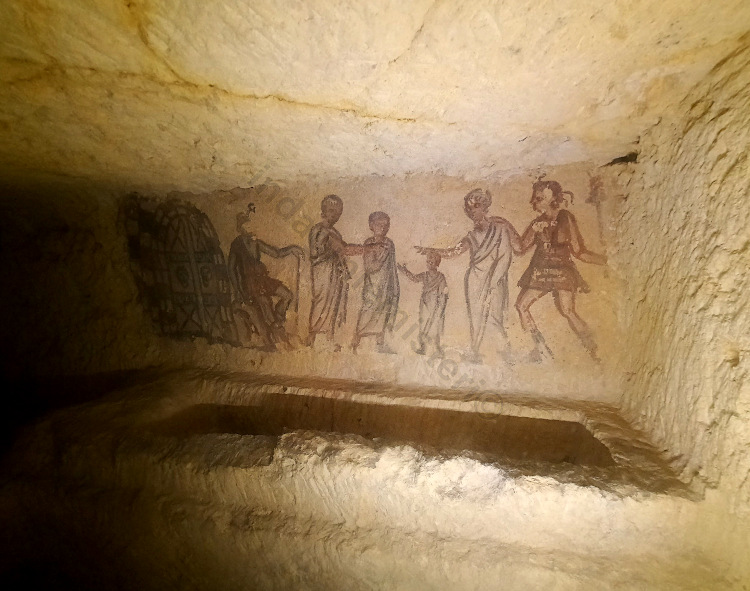
Tuchulca, snake-haired, struck souls with a scythe to cleanse them from the sins of earthly life. Finally, the deities Aita and Persipnei, who were consorts, presided over the eternal banquet in the realm of the dead.
Samuele Corrente Naso, translation by Daniela Campus
Map of places
Notes
- M. Torelli, Storia degli Etruschi, Editori Laterza, Bari, 1984. ↩︎
- M. Cristofani, Dizionario illustrato della civiltà etrusca, Giunti Editore, Milano, 1999. ↩︎
- M. Pallottino, Etruscologia, Hoepli, Settima Edizione Rinnovata, Milano, 1984. ↩︎
- M. Cristofani (a cura di), Etruschi, Giunti Gruppo Editoriale, 1984. ↩︎

